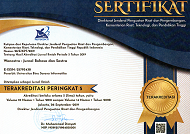TEACHING ENGLISH SPEAKING THROUGH INFORMATION GAP TECHNIQUE (A Classroom Action Research at the 8th Grade Students of Madrasah Tsanawiyah Al-Husna Depok)
Abstract
Abstract: Speaking is an important skill in learning English. However, the teacher still need an appropriate technique to teach speaking. So that, the writer used Information Gap technique in learning English speaking. This study aims to apply Information-Gap techniques in teaching speaking English in 8th grade students at MTs.Al-Husna Depok. In this study, the writer uses A Classroom Action Research (CAR). The writer analyzes and collects data during the teaching process through; interviews, observation, literature study, and the internet. Moreover, in order to collect the result of the significant differences before and after of using Information Gap, the writer uses pre-test and post-test during the observation. The research findings include: 1) Information Gap is an interesting technique in learning speaking, so that the students can enjoy the learning process. 2) With the Information Gap technique can make students more active in communication, and increase the courage and confidence of students. 3) In addition, by applying this technique students do not feel bored, because there are many different and interesting activities in Information Gap technique. So, it can be concluded that the Information Gap technique is very effective in teaching English speaking to students.
Keyword: Teaching, Speaking, Information Gap Technique
Abstract: Speaking is an important skill in learning English. However, the teacher still need an appropriate technique to teach speaking. So that, the writer used Information Gap technique in learning English speaking. This study aims to apply Information-Gap techniques in teaching speaking English in 8th grade students at MTs.Al-Husna Depok. In this study, the writer uses A Classroom Action Research (CAR). The writer analyzes and collects data during the teaching process through; interviews, observation, literature study, and the internet. Moreover, in order to collect the result of the significant differences before and after of using Information Gap, the writer uses pre-test and post-test during the observation. The research findings include: 1) Information Gap is an interesting technique in learning speaking, so that the students can enjoy the learning process. 2) With the Information Gap technique can make students more active in communication, and increase the courage and confidence of students. 3) In addition, by applying this technique students do not feel bored, because there are many different and interesting activities in Information Gap technique. So, it can be concluded that the Information Gap technique is very effective in teaching English speaking to students.
Keyword: Teaching, Speaking, Information Gap Technique
Full Text:
PDFReferences
BIBLIOGRAPHY
Afrizal, M. (2015). A Classroom Action Research: Improving Speaking Skills Through Information Gap Activities. English Education Journal, 342–355.
Anggraini. (2018). Improving Students ’ Speaking Skill Through CLT An Action Research. X(1), 17–23.
Alawiah, S. (2018). The Effects of Student ’ s Perception on Role Play Technique and Student ’ s Learning Motivation on Speaking Skills. Wanastra, X(1).
Bekele Abate, E. (2014). Prospects and Challenges of Communicative Approach in EFL Context. 4(25), 2225–2484.
Christianto, D. (2019). Teachers’ Perceptions On tThe Use Communicative Language Teaching Approach In The English Classrooms. 3(1), 90–101.
Daniel, J.L.M. (2012). Superstar Personal Info Questions. https://en.islcollective.com
Dalgaard, R. (2016). Bedroom information gap activity. https://en.islcollective.com
Defrioka, A. (2009). Improving Students’ Interaction in Speaking Class Through Information Gap Activities.
Giving directions. Https://englishteens.britishcouncil.or
Jack R, Fraenkel. (2001). How To Design and Evaluate Research in Education. In New York:McGraw-Hill Companies , Inc., 2012. New York.
Nuraeni. (2014). The Effectiveness of Information - gap toward Students’ Speaking Skill.
Nurvia, S. R. I. (2016). Using Song in Teaching English Speaking Skills English Language Teaching Department Tarbiyah and Teacher Training Faculty of Syekh Nurjati State Islamic Institute. (14111320130).
Pakula, H.-M. (2019). Teaching speaking. Apples – Journal of Applied Language Studies, Vol. 13, pp. 95–111. https://doi.org/10.17011/apples/urn.201903011691
Palupi, M. E. (2017). Assessing Grammatical Comprehension Capabilities of 2nd Semester English Class Students. Wanastra, IX(2).
Richards, J. C. (2006). Communicative Language Teaching Today.
Putra, O. P. (2014). The Analysis Of Teaching Things Through Oral Repetition. 6.
Rosdalina. (2014). Improving student`s speaking skill trought animation movie at sixth grade sdn 002 ujungbatu kabupaten rokan hulu provinsi riau. ll.
Sartika, D. (2016). Teaching Speaking using the Information Gap Technique. English Education Journal, 7(3), 273–285.
Sinaga Boru Riska, N. (2017). APPLYING THREE TYPES OF INFORMATION GAP TASK IN SPEAKING CLASS AT THE SECOND GRADE OF SMA NEGERI 1 SEPUTIH MATARAM.
Sugiarti, D. (2014). Using Information-Gap Activities To Improve The English Speaking Skills Of XI KR 4 Students At SMK NEGERI 3 Yogyakarta In The Academic Year of 2013/2014.
Zuhriyah, M. (2017). Storytelling to Improve Students’ Speaking Skill. English Education: Jurnal Tadris Bahasa Inggris, 10(1), 119–134. Retrieved from http://ejournal.radenintan.ac.id/index.php/ENGEDU/article/view/879/753
DOI: https://doi.org/10.31294/w.v11i2.6224
Copyright (c) 2019 Yanti Rosalinah, Nurul Khilda

This work is licensed under a Creative Commons Attribution-ShareAlike 4.0 International License.
Index by:
Published by Department of Research and Community Service (LPPM) Universitas Bina Sarana Informatika by supported Relawan Jurnal Indonesia
Jl. Kramat Raya No.98, Kwitang, Kec. Senen, Jakarta Pusat, DKI Jakarta 10450

This work is licensed under a Creative Commons Attribution-ShareAlike 4.0 International License






